A Dynamic Evaluation Method for Pumped Storage Units Adapting to Asymmetric Evolution of Power System
Abstract
1. Introduction
- Compared with traditional evaluation methods, the proposed approach considers the asymmetric evolutionary development of the power system over long time spans, improves static evaluation into a dynamic method, and accurately characterizes the supporting role of PSU in the construction of NPS, while avoiding scoring errors caused by power system asymmetric evolution in traditional methods.
- The proposed method derives various indicators for PSU from relevant policy documents and balances conflicts between subjective and objective weights based on game theory, ensuring comprehensive indicator coverage and symmetrical, balanced weighting. By introducing a cloud model to characterize the uncertainty and asymmetry of evaluation results, the adaptability of the evaluation process and the interpretability of the results are enhanced.
- Based on the asymmetric evolution requirements of the power system, this paper proposes improvements to enhance the performance of PSU. These suggestions provide feasible pathways for equipment upgrading and full life-cycle planning.
2. Evaluation Method Based on Evolutionary Combination Weighting and Cloud Model
2.1. Subjective Weight Determination Method
2.2. Objective Weight Determination Method
2.3. Evolutionary Combination Weighting Method
2.4. Comprehensive Evaluation Method Based on Cloud Model
3. Construction of an Evaluation System for PSU
3.1. Construction of the PSU Evaluation System
- Energy Regulation Capability refers to the ability of PSU to regulate energy storage and release within the power system. This capability ensures that the units can effectively mitigate fluctuations from renewable energy sources, achieve peak-valley energy transfer, and provide system reserves. Its quantitative evaluation includes three key indicators: rated capacity (MW), full generation/pumping duration (h).
- Transition capability of PSU through multiple operating conditions describes its dynamic performance in rapidly switching between various operational states. This represents the core advantage of pumped storage over other flexible resources, enabling it to meet rapid dispatch requirements in highly volatile power systems. Its performance is characterized by four indicators: transition time from pumping full load to standstill (s), transition time from generation full load to standstill (s), transition time from generation phase modulation to standstill (s), and transition time from generation phase modulation to no-load (s). The transition times between various operating conditions can be obtained using Equation (18).where represents the transition time of the operating condition; m is the index of the corresponding transition condition; and are the start time and end time of the transition, respectively.
- Wide-load operation capability of PSU in generation mode indicates the ability of a unit to operate safely and stably over a wide load range beyond its rated operating point during generation. Its main evaluation indicators include three third-level metrics: frequency measurement resolution (mHz), primary frequency regulation response time (s), and steady-state power control error (%). The frequency measurement resolution refers to the minimum variation in frequency that the measurement system can identify and respond to. The primary frequency response time and the steady-state power control error are defined by Equations (19) and (20), respectively.where is the primary frequency response time; is the time when the system frequency exceeds the limit; is the moment when the unit output reaches 90% of the target frequency regulation power.where represents the power control error; is the steady-state average of the actual output power; is the power setpoint; is the rated power of the unit.
- Reactive power response capability of PSU refers to the unit’s service capacity in providing reactive power to regulate system voltage and improve power quality. It encompasses four third-level indicators: ceiling voltage multiple of the excitation system (p.u.), voltage rise time of the excitation system (s), voltage response time of the excitation system (s), and maximum reactive power increase capability (Mvar). The reactive power response capability of the PSU can be evaluated by the following four metrics, as defined in Equations (21)–(24):where and represent the PSU’s excitation system ceiling voltage ratio, excitation system voltage rise time, excitation system voltage response time, and maximum reactive power increment capability, respectively. and are the maximum voltage provided by the excitation system and the rated voltage of the excitation system; and are the times when the step response curve reaches 10% and 90% of the target voltage value, respectively. and are the initial moment when the step voltage command is applied and the moment when the output voltage reaches 95% of the target value, respectively. and are the maximum reactive power the unit can provide and the initial reactive power, respectively.
3.2. Evaluation Grade Classification for PSU
4. Case Study
4.1. Acquisition of Evolutionary Indicator Weights
4.2. Evaluation Results Based on Cloud Model
4.3. Improvement Suggestions
5. Conclusions and Future Work
- The proposed method takes into account the asymmetric evolution of the power system over extended time spans. By dynamically modifying indicator weights through an evolutionary response function, compared to existing evaluation methods, the proposed method reduces the expected scoring deviations of secondary indicators by approximately 4.7%, 1.3%, 3.5%, and 7.7%, respectively, with an overall scoring deviation reduction of about 6.4%. This enables a dynamic and accurate evaluation of the capability of PSU to support the construction of NPS.
- The proposed method employs AHP and EWM to determine the subjective and objective weights of indicators of PSU. Using game theory, it obtains optimal combination coefficients for these subjective and objective weights, achieving the symmetry and balance between both factors. Furthermore, by integrating a cloud model to represent the randomness and fuzziness of evaluation boundaries, the method enhances the adaptability of the evaluation process and the interpretability of the results.
- The improvement suggestions incorporating evolutionary weights enhance the applicability of unit optimization selection. They not only enable a dynamic response to structural and systemic changes in NPS at different asymmetric development stages but also provide an effective decision-making basis for the long-term planning and flexible retrofitting of PSU.
Author Contributions
Funding
Data Availability Statement
Conflicts of Interest
Abbreviations
| PSS | Pumped storage station |
| PSU | Pumped storage unit |
| NPS | New-type power system |
| AHP | Analytic hierarchy process |
| EWM | Entropy weight method |
| QRNN | Quantile regression neural networks |
| MSM | Multi-head self-attention mechanism |
| Ex | Expectation (Cloud Model parameter) |
| En | Entropy (Cloud Model parameter) |
| He | Hyper-entropy (Cloud Model parameter) |
References
- Mallapaty, S. How China could be carbon neutral by mid-century. Nature 2020, 586, 482–483. [Google Scholar] [CrossRef]
- Li, C.; Wen, X.; Zhang, Y.; Guo, R.; Peng, S. Research on environmental evaluation index of carbon-based power generation formats under the “dual carbon goals”. Energies 2025, 18, 4337. [Google Scholar] [CrossRef]
- Liu, Y.; Luo, L.; Li, X.; Liu, H.; Yu, Z.; Wang, Y. A Wasserstein distance-based distributionally robust optimization strategy for a renewable energy power grid considering meteorological uncertainty. Symmetry 2025, 17, 1602. [Google Scholar] [CrossRef]
- Ge, Y.; Xie, J.; Chang, J.; Feng, S. A multi-objective deep reinforcement learning method for intelligent scheduling of wind-solar-hydro-battery complementary generation systems. Int. J. Electr. Power Energy Syst. 2025, 167, 110635. [Google Scholar] [CrossRef]
- Qu, Y.; Liu, C.; Tong, X.; Xie, Y. Stochastic programming-based annual peak-regulation potential assessing method for virtual power plants. Symmetry 2025, 17, 683. [Google Scholar] [CrossRef]
- Papakonstantinou, A.G.; Konstanteas, A.I.; Papathanassiou, S.A. Solutions to enhance frequency regulation in an island system with pumped-hydro storage under 100% renewable energy penetration. IEEE Access 2023, 11, 76675–76690. [Google Scholar] [CrossRef]
- Chen, X.; Wu, P.; He, H.; Song, B.; Qin, K.; Teng, X.; Yang, F.; Li, D. Optimal flexibility dispatching of multi-pumped hydro storage stations considering the uncertainty of renewable energy. Symmetry 2024, 16, 1404. [Google Scholar] [CrossRef]
- Mahfoud, R.J.; Alkayem, N.F.; Zhang, Y.; Zheng, Y.; Sun, Y.; Alhelou, H.H. Optimal operation of pumped hydro storage-based energy systems: A compendium of current challenges and future perspectives. Renew. Sustain. Energy Rev. 2023, 178, 113267. [Google Scholar] [CrossRef]
- O’Dwyer, C.; Ryan, L.; Flynn, D. Efficient Large-Scale Energy Storage Dispatch: Challenges in Future High Renewable Systems. IEEE Trans. Power Syst. 2017, 32, 3439–3450. [Google Scholar] [CrossRef]
- Han, S.; He, M.; Yuan, Y.; Hunt, J.D.; Zhao, Z.; Li, G.; Chen, D. Evaluating the performance of seasonal pumped hydro storage coordinated operation with cascade hydropower station integrating variable renewable energy. Renew. Energy 2025, 256, 124023. [Google Scholar] [CrossRef]
- Zhang, J.; Cheng, C.; Yu, S.; Shen, J.; Wu, X.; Su, H. Preliminary feasibility analysis for remaking the function of cascade hydropower stations to enhance hydropower flexibility: A case study in China. Energy 2022, 260, 125163. [Google Scholar] [CrossRef]
- Li, P.; Zhao, Z.; Li, J.; Liu, Z.; Liu, Y.; Mahmud, M.A.; Sun, Y.; Chen, D. Unlocking potential contribution of seasonal pumped storage to ensure the flexibility of power systems with high proportion of renewable energy sources. Renew. Energy 2023, 218, 119280. [Google Scholar] [CrossRef]
- Wang, Z.; Tan, Q.; Wen, X.; Su, H.; Fang, G.; Wang, H. Capacity optimization of retrofitting cascade hydropower plants with pumping stations for renewable energy integration: A case study. Appl. Energy 2025, 377, 124429. [Google Scholar] [CrossRef]
- Jin, X.; Liu, B.; Liao, S.; Cheng, C.; Zhang, Y.; Zhao, Z.; Lu, J. Wasserstein metric-based two-stage distributionally robust optimization model for optimal daily peak shaving dispatch of cascade hydroplants under renewable energy uncertainties. Energy 2022, 260, 125107. [Google Scholar] [CrossRef]
- Lei, L.; Xiao, Y.; Gao, Y.; Chen, D.; Zhao, Z.; Zhou, Y.; Chen, H.; Mahmud, M.A. Breaking time-scale boundary: An optimization framework for improving multi-timescale operation characteristics of pumped storage power plant. Appl. Energy 2025, 398, 126387. [Google Scholar] [CrossRef]
- Zhang, Z.; Dai, H.; Wang, Y. Long-medium-short term nested operation model of hydro-wind-solar hybrid power system considering flood control, power generation, ecology and navigation. Energy 2025, 334, 137705. [Google Scholar] [CrossRef]
- Sun, X.; He, Y.; Yang, J.; Zhao, Z.; Yang, Y.; Li, M.; Zhang, M.; Chen, D.; Bai, Z. Optimization and comparative analysis of hydrogen energy storage and pumped hydro storage capacity configuration for enhancing power system flexibility in clean energy bases. Energy Convers. Manag. 2025, 342, 120144. [Google Scholar] [CrossRef]
- Zhu, Z.; Wang, L.; Wang, X.; Jiang, C.; Zhou, S.; Gong, K. Complementary operations of multi-renewable energy systems with pumped storage. CSEE J. Power Energy Syst. 2023, 9, 1866–1880. [Google Scholar]
- Wang, R.; Yang, W.; Huang, Y.; Li, X.; Liu, Y.; Chen, J.; Cheng, Q.; Mei, Y.; Cheng, Y.; Liu, P. Coordinating regulation reliability and quality of pumped storage units for renewables by a novel scheduling-control synergic model. Appl. Energy 2024, 376, 124162. [Google Scholar] [CrossRef]
- Wang, Z.; Yang, W.; Wu, P.; Song, K.; Li, G. Power regulation stability of variable-speed pumped-storage units: Influence law, deviation recognition, and performance quantification. J. Energy Storage 2025, 132, 117972. [Google Scholar] [CrossRef]
- Lei, Z.; Zhong-Hua, G.; Shan-Ying, L.; Yi-An, Y.; Lian-Tao, J.; Rong-Rong, J.; Zhi-Feng, T.; Ze, L. Dynamic performance evaluation of variable speed pumped storage units based on multiple physical fields of hydraulic, machinery, and electricity. In Proceedings of the 2024 6th Asia Energy and Electrical Engineering Symposium (AEEES), Chengdu, China, 28–31 March 2024; pp. 28–31. [Google Scholar]
- Ling, X.; Wang, Y.; Zhang, M.; Cui, S. Optimization and evaluation of coordinated operation strategy for hybrid pumped storage power plant. In Proceedings of the 2025 7th International Conference on Energy Systems and Electrical Power (ICESEP), Wuhan, China, 20–22 June 2025; pp. 25–27. [Google Scholar]
- Peng, Y.; Yang, Y.; Chen, M.; Wang, X.; Xiong, Y.; Wang, M.; Li, Y.; Zhao, B. Value evaluation method for pumped storage in the new power system. Chin. J. Electr. Eng. 2023, 9, 26–38. [Google Scholar] [CrossRef]
- Yang, Y.; Yang, Y.; Lu, Q.; Liu, D.; Xie, P.; Wang, M.; Yu, Z.; Liu, Y. Comprehensive evaluation of a pumped storage operation effect considering multidimensional benefits of a new power system. Energies 2024, 17, 4449. [Google Scholar] [CrossRef]
- Zhang, X.; Jiang, Y.; Wang, X.-B.; Li, C.; Zhang, J. Health condition assessment for pumped storage units using multihead self-attentive mechanism and improved radar chart. IEEE Trans. Ind. Inform. 2022, 18, 8087–8097. [Google Scholar] [CrossRef]
- Tan, Y.; Xie, G.; Xiao, Y.; Luo, Y.; Xie, X.; Wen, M. Comprehensive benefit evaluation of hybrid pumped-storage power stations based on improved rank correlation-entropy weight method. Energies 2022, 15, 8414. [Google Scholar] [CrossRef]
- Saaty, T.L. Relative measurement and its generalization in decision making—Why pairwise comparisons are central in mathematics for the measurement of intangible factor, the analytic hierarchy/network process. Rev. R. Acad. Cienc. Exactas Fis. Nat. Ser. A Mat. 2008, 102, 251–318. [Google Scholar] [CrossRef]
- Zhao, K.; Dai, Y.; Ji, Y.; Jia, Z. Decision-making model to portfolio selection using analytic hierarchy process (AHP) with expert knowledge. IEEE Access 2021, 9, 76875–76893. [Google Scholar] [CrossRef]
- Xu, C.; Xu, C.; Li, G. Establishment and validation of a novel composite index for energy efficiency evaluation of data center chilled water systems based on AHP and Entropy Weight Method. Energy Build. 2025, 337, 115677. [Google Scholar] [CrossRef]
- Du, L.; Niu, Z.; Zhang, R.; Zhang, J.; Jia, L.; Wang, L. Evaluation of water resource carrying potential and barrier factors in Gansu Province based on game theory combined weighting and improved TOPSIS model. Ecol. Indic. 2024, 166, 112438. [Google Scholar] [CrossRef]
- Li, D.; Cheung, D.; Shi, X.; Ng, V. Uncertainty reasoning based on cloud models in controllers. Comput. Math. Appl. 1998, 35, 99–123. [Google Scholar] [CrossRef]
- Jiang, T.; Xu, Z.; He, X.; Xia, B.; Ke, Y.; Skitmore, M.; Liu, Y. Evaluating the resilience of social license to operate towards NIMBY facilities: A cloud model-based approach. Environ. Impact Assess. Rev. 2025, 112, 107808. [Google Scholar] [CrossRef]
- The Blue Book of New Type Power System Developing in China. Available online: http://www.nea.gov.cn/download/xxdlxtfzlpsgk.pdf (accessed on 15 April 2025).
- Medium-and Long-Term Development Plan for Pumped Storage (2021–2035) of China. Available online: https://zfxxgk.nea.gov.cn/1310193456_16318589869941n.pdf (accessed on 22 April 2025).
- 14th Five-Year Plan for a Modern Energy System of China. Available online: https://zfxxgk.nea.gov.cn/1310524241_16479412513081n.pdf (accessed on 8 May 2025).
- Opinions on Improving Institutional Mechanisms and Policy Measures for Green and Low-Carbon Energy Transition of China. Available online: https://www.gov.cn/zhengce/zhengceku/2022-02/11/content_5673015.htm (accessed on 19 May 2025).
- Okoli, C.; Pawlowski, S.D. The Delphi method as a research tool: An example, design considerations and applications. Inf. Manag. 2004, 42, 15–29. [Google Scholar] [CrossRef]
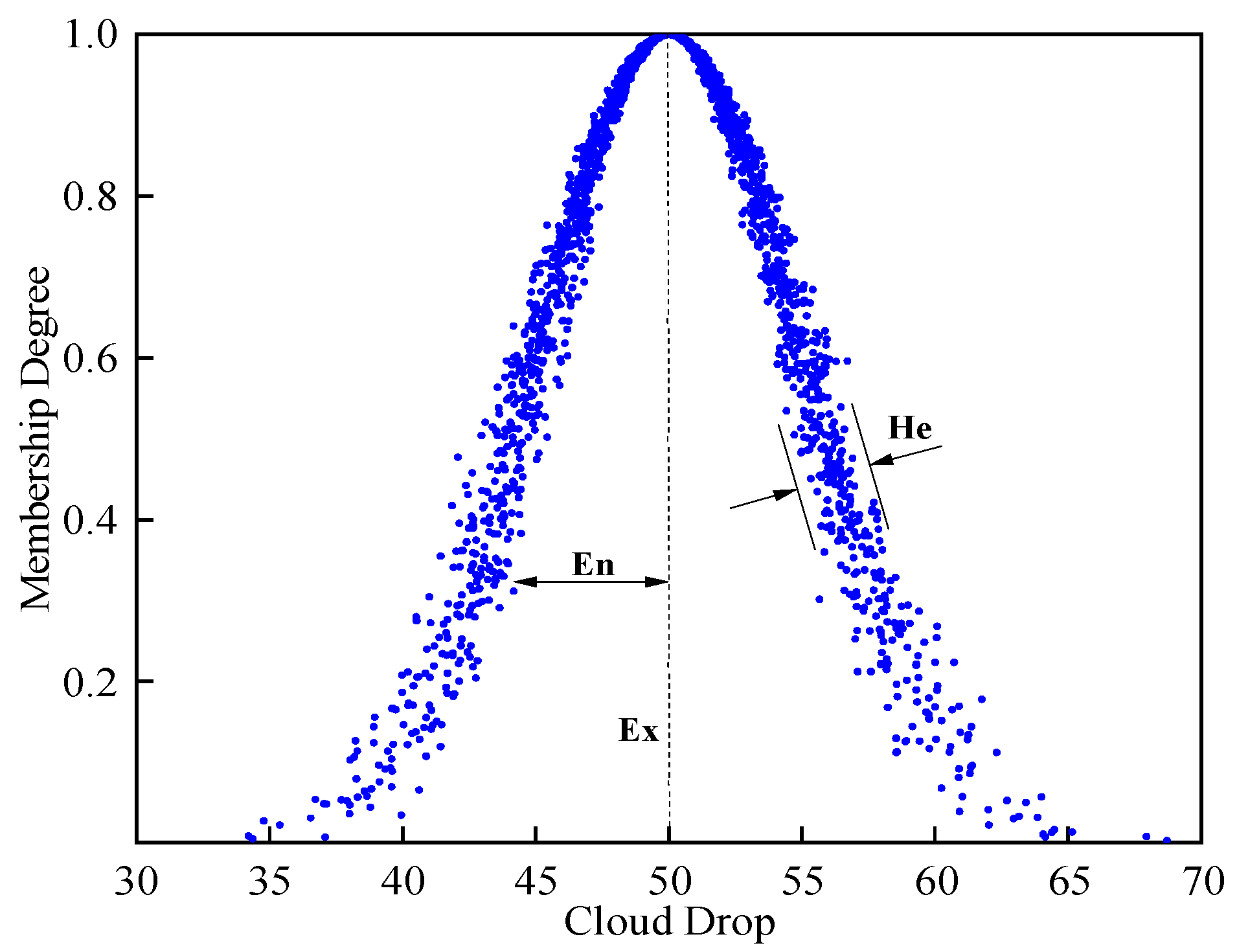

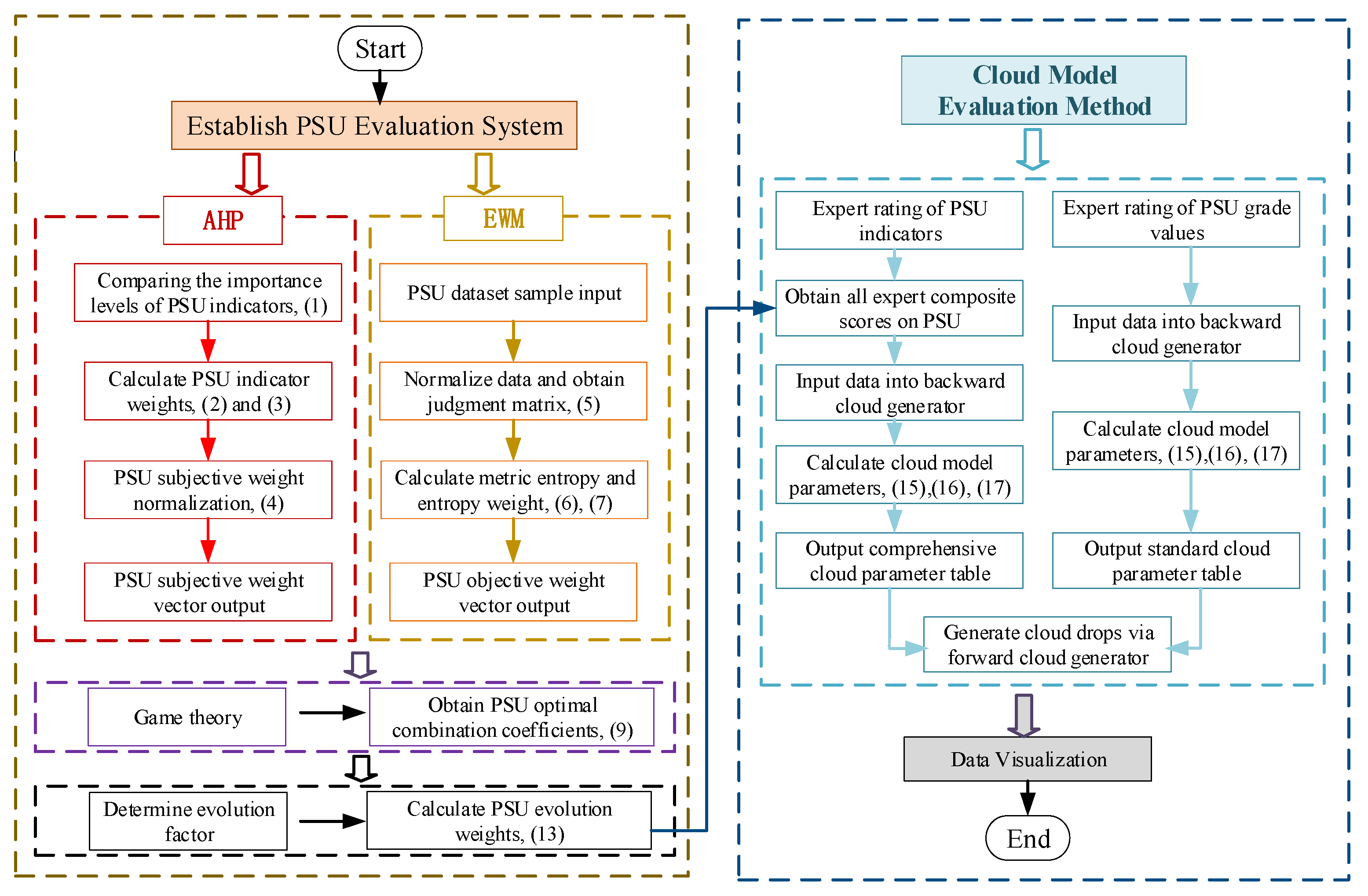

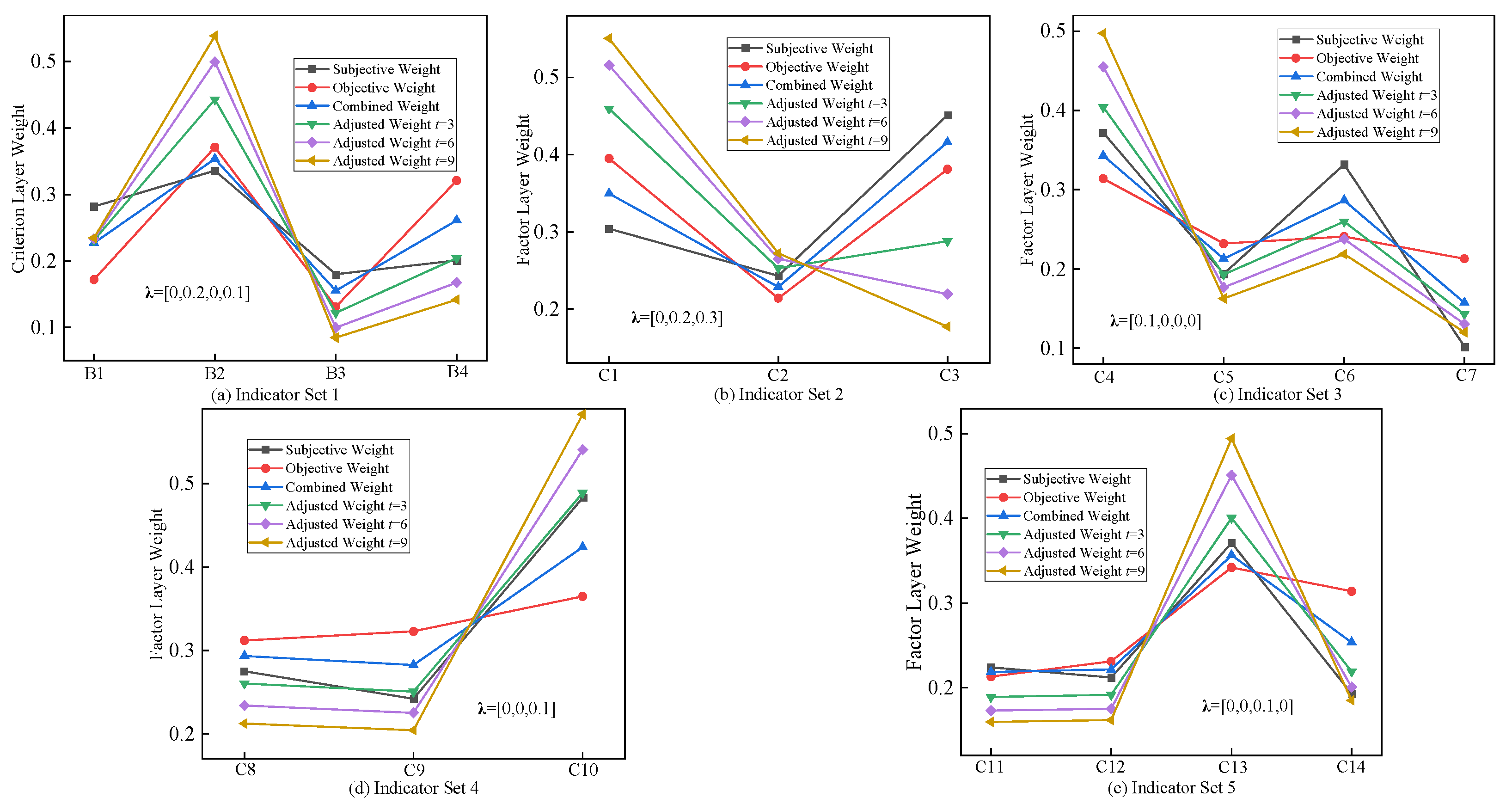
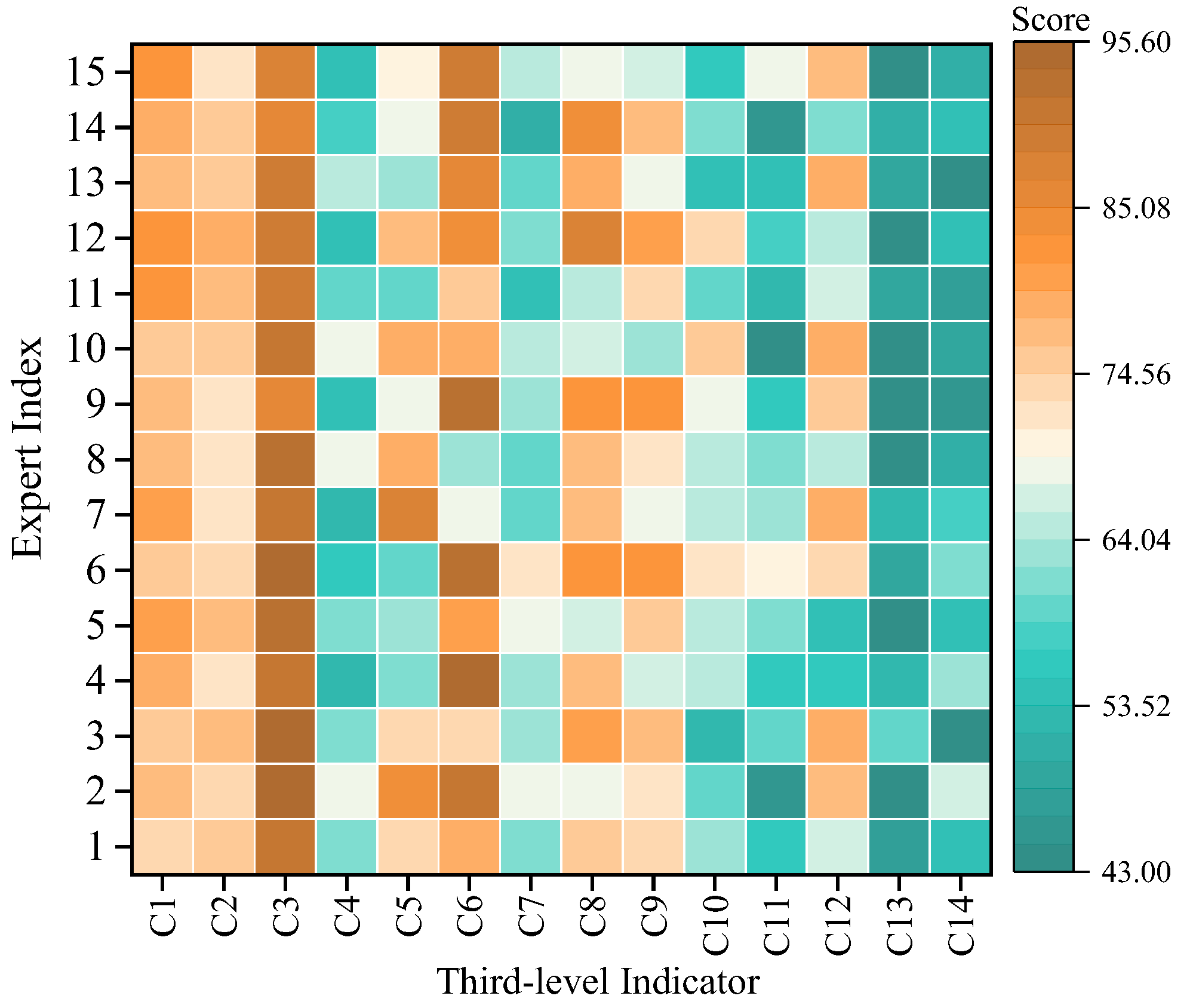


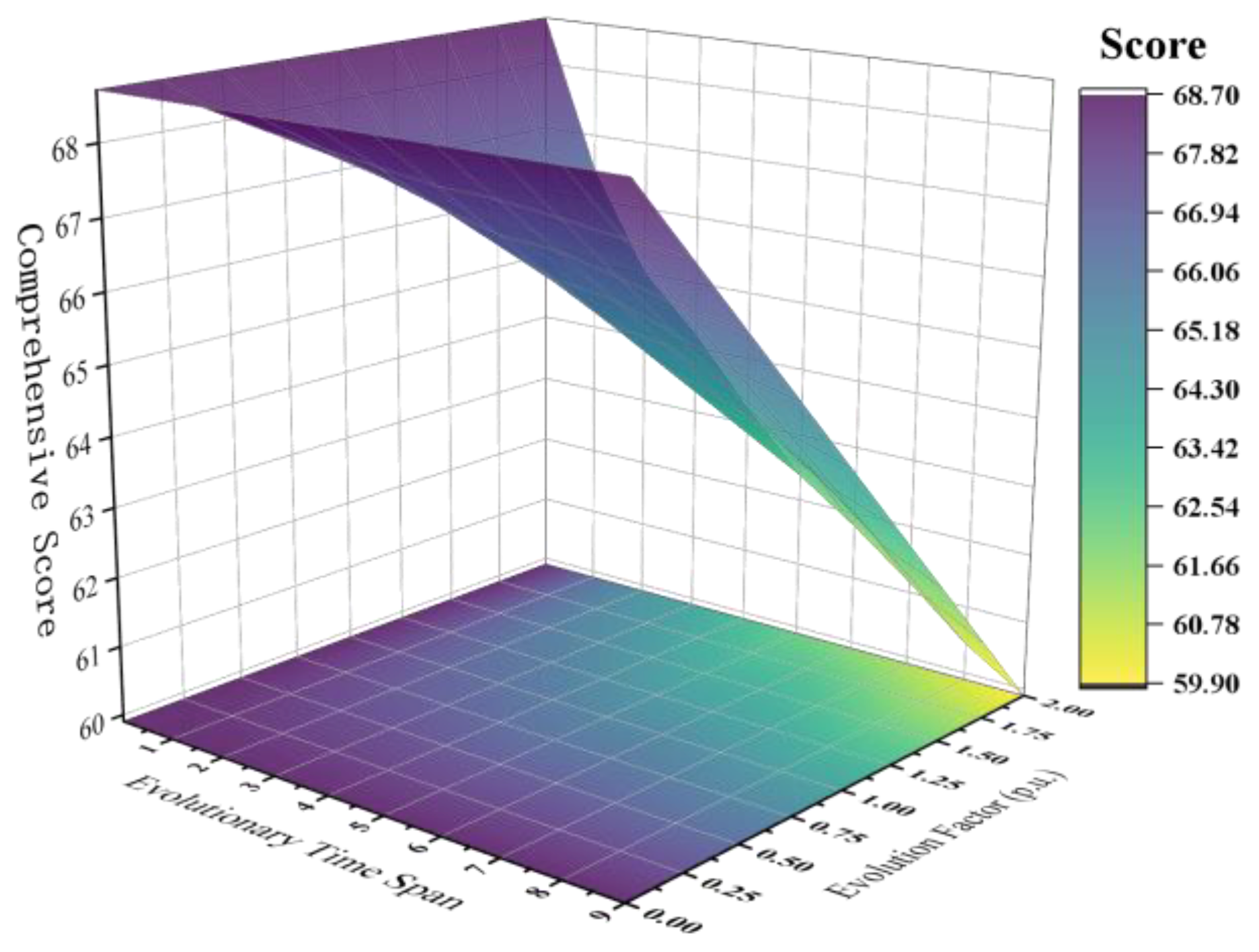
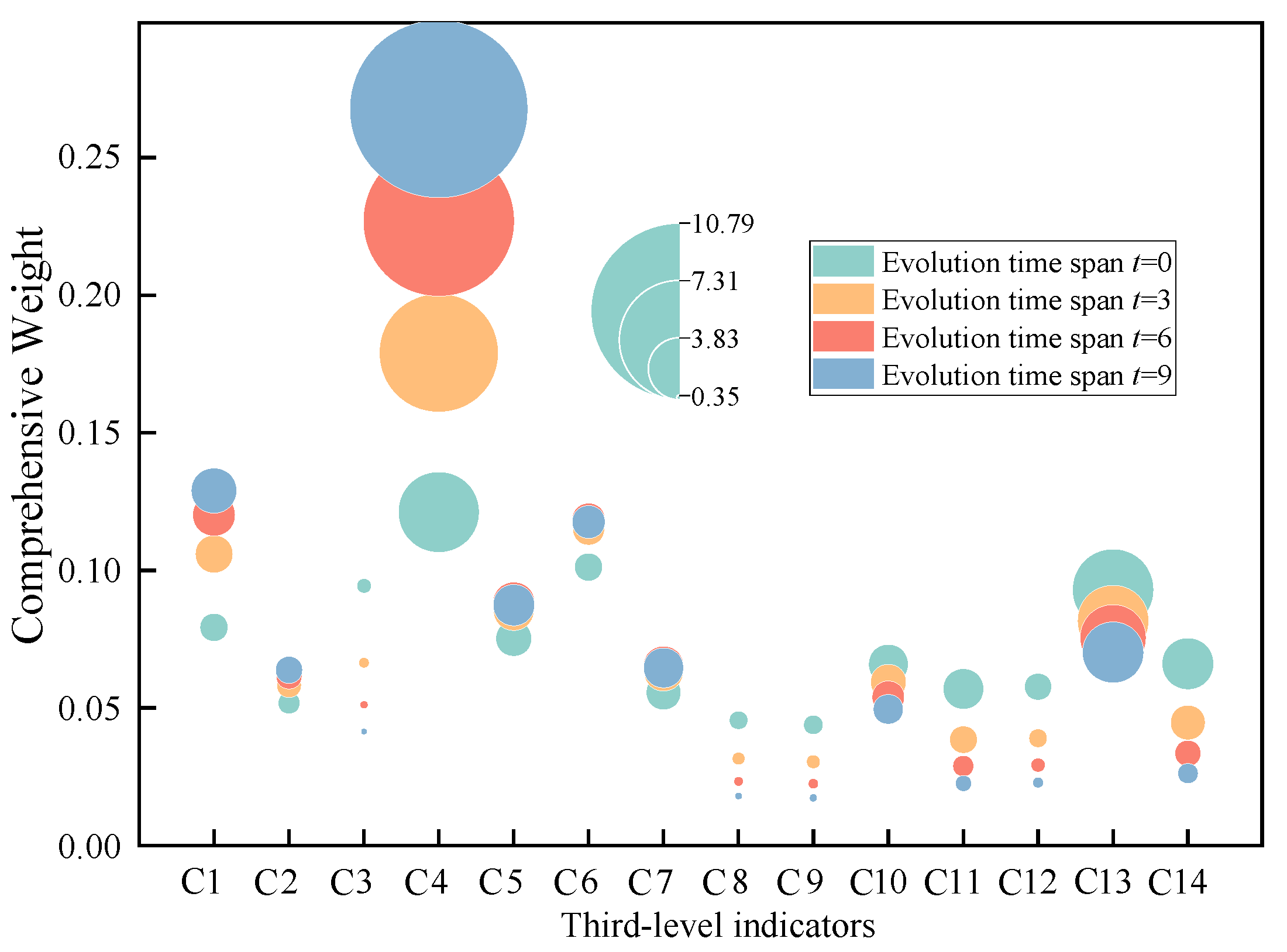
| Year | Reference | Core Method/Model | Considered Factors | Main Contribution |
|---|---|---|---|---|
| 2022 | Ref. [25] | QRNN-MSM | Health Degree | Interactions among multiple factors |
| 2022 | Ref. [26] | Improved rank correlation-entropy weight method | Function, Economy, Environment | Multi-weight fusion |
| 2023 | Ref. [23] | Operation simulation-based method | Economy, Safety, Environment | Multi-dimensional value |
| 2023 | Ref. [11] | Analytic hierarchy process-cloud model | Economy | Refined evaluation model |
| 2024 | Ref. [24] | Operation simulation-based method | Economy, Environment | Demonstrates actual operation effects |
| 2025 | Ref. [22] | Analytic hierarchy process | Performance, Economy | Quantifies synergistic benefits |
| -- | This paper | Dynamic combination weighting | Technology, Operation | Dynamic evolution process |
| Grade | Parameters of Layer A | Parameters of Layer B1 | Parameters of Layer B2 | Parameters of Layer B3 | Parameters of Layer B4 |
|---|---|---|---|---|---|
| Excellent | (90.3, 2.1, 0.3) | (95.3, 1.2, 0.2) | (90.2, 2.2, 0.2) | (93.1, 1.4, 0.2) | (88.1, 1.8, 0.3) |
| Good | (79.6, 3.6, 0.5) | (82.0, 1.4, 0.4) | (77.8, 2.4, 0.4) | (81.3, 1.9, 0.1) | (75.3, 1.9, 0.1) |
| Satisfactory | (70.2, 2.3, 0.4) | (69.5, 1.7, 0.3) | (65.4, 2.6, 0.3) | (69.0, 2.1, 0.3) | (62.4, 2.1, 0.2) |
| Average | (59.7, 3.7, 0.1) | (60.3, 2.9, 0.4) | (52.9, 2.3, 0.1) | (56.0, 1.7, 0.4) | (49.0, 2.6, 0.3) |
| Poor | (40.5, 5.3, 0.6) | (45.0, 3.2, 0.6) | (40.1, 3.1, 0.4) | (42.7, 3.3, 0.3) | (38.2, 3.1, 0.7) |
| Period of Evolution | Parameters of Layer A | Parameters of Layer B1 | Parameters of Layer B2 | Parameters of Layer B3 | Parameters of Layer B4 |
|---|---|---|---|---|---|
| t = 0 | (68.7, 3.2, 0.5) | (80.7, 1.3, 0.1) | (68.3, 3.6, 0.7) | (72.1, 3.1, 0.5) | (58.3, 3.5, 0.7) |
| t = 3 | (66.6, 3.1, 0.5) | (78.9, 1.4, 0.1) | (68.7, 3.5, 0.8) | (71.2, 3.2, 0.5) | (55.9, 3.6, 0.6) |
| t = 6 | (65.3, 3.1, 0.4) | (77.6, 1.4, 0.1) | (68.9, 3.4, 0.8) | (70.3, 3.3, 0.5) | (54.4, 3.6, 0.6) |
| t = 9 | (64.3, 3.1, 0.4) | (76.9, 1.5, 0.2) | (69.2, 3.4, 0.9) | (69.6, 3.3, 0.6) | (53.8, 3.6, 0.5) |
| Time Span | First-Round Mean Score | Second-Round Mean Score | Third-Round Mean Score | Mean Absolute Error |
|---|---|---|---|---|
| t = 0 | 68.7 | 68.2 | 68.5 | 0.51% |
| t = 3 | 66.6 | 66.9 | 67.1 | 0.60% |
| t = 6 | 65.3 | 65.7 | 65.5 | 0.46% |
| t = 9 | 64.3 | 64.6 | 64.4 | 0.31% |
Disclaimer/Publisher’s Note: The statements, opinions and data contained in all publications are solely those of the individual author(s) and contributor(s) and not of MDPI and/or the editor(s). MDPI and/or the editor(s) disclaim responsibility for any injury to people or property resulting from any ideas, methods, instructions or products referred to in the content. |
© 2025 by the authors. Licensee MDPI, Basel, Switzerland. This article is an open access article distributed under the terms and conditions of the Creative Commons Attribution (CC BY) license (https://creativecommons.org/licenses/by/4.0/).
Share and Cite
Chen, L.; Wang, Y.; Xue, H.; Deng, L.; Zhong, Z.; Jia, X.; Feng, S.; Xie, J. A Dynamic Evaluation Method for Pumped Storage Units Adapting to Asymmetric Evolution of Power System. Symmetry 2025, 17, 1900. https://doi.org/10.3390/sym17111900
Chen L, Wang Y, Xue H, Deng L, Zhong Z, Jia X, Feng S, Xie J. A Dynamic Evaluation Method for Pumped Storage Units Adapting to Asymmetric Evolution of Power System. Symmetry. 2025; 17(11):1900. https://doi.org/10.3390/sym17111900
Chicago/Turabian StyleChen, Longxiang, Yuan Wang, Hengyu Xue, Lei Deng, Ziwei Zhong, Xuan Jia, Shuo Feng, and Jun Xie. 2025. "A Dynamic Evaluation Method for Pumped Storage Units Adapting to Asymmetric Evolution of Power System" Symmetry 17, no. 11: 1900. https://doi.org/10.3390/sym17111900
APA StyleChen, L., Wang, Y., Xue, H., Deng, L., Zhong, Z., Jia, X., Feng, S., & Xie, J. (2025). A Dynamic Evaluation Method for Pumped Storage Units Adapting to Asymmetric Evolution of Power System. Symmetry, 17(11), 1900. https://doi.org/10.3390/sym17111900






